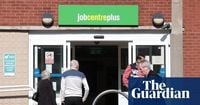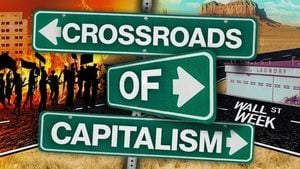Britain’s jobs market is showing unmistakable signs of strain as the country’s unemployment rate jumped to 5% in the three months to September 2025, according to official data released by the Office for National Statistics (ONS). This marks the highest level of unemployment since the tumultuous days of the Covid-19 pandemic in early 2021, and the figure has come as an unwelcome surprise, outpacing analysts’ expectations and casting a shadow over the nation’s economic outlook just weeks before the government’s pivotal autumn budget.
To put this in perspective, the latest ONS numbers reveal a rise from 4.8% in the previous quarter, exceeding the consensus forecast of 4.9%. City economists had anticipated a more modest uptick, but the reality has proven harsher. The jobless total now stands at 1.8 million people, a figure unseen since the height of pandemic lockdowns. Liz McKeown, director of economic statistics at the ONS, summed up the situation: “Taken together, these figures point to a weakening labour market. Meanwhile the unemployment rate is up in the latest quarter to a post-pandemic high. The number of job vacancies, however, remains broadly unchanged.”
Despite these ominous indicators, there are some nuances to consider. The number of people claiming unemployment benefits—nearly 1.7 million—has actually dipped slightly compared to a year ago. Yet, the number of people on company payrolls has fallen by 180,000 in the year to October, a 0.6% drop, according to HM Revenue & Customs. This decline is particularly significant as it mirrors the kind of payroll contraction last seen during the pandemic, highlighting the fragility of the current labor market.
Sector-specific pain has been acute. The largest falls in payrolled employment have occurred in wholesale and retail, accommodation and food services, and IT. Over the past year, job vacancies have remained broadly flat at about 723,000 between August and October, but this is 99,000 fewer than the same period last year. Suren Thiru, economics director at the Institute of Chartered Accountants in England and Wales, noted, “These figures suggest that the UK’s labour market is suffering from pre-budget jitters, as businesses already weakened by April’s rise in national insurance look to cut recruitment further in anticipation of another difficult budget.”
It’s not just the unemployment rate that’s causing concern. Wage growth is faltering as well. Average wage growth slipped to 4.6% in the third quarter, down from 4.7% in the previous three months and marking the weakest increase since the spring of 2022. Public sector workers saw a 6.6% rise, while the private sector lagged behind at 4.2%. Yael Selfin, chief economist at KPMG UK, observed that public sector pay growth was “approaching a peak,” as last year’s big pay rises are unlikely to continue amid government budget pressures. She added, “Private sector pay growth is anticipated to fall further with more people in the labour market seeking work, weakening workers’ bargaining power.”
With the Labour government under Prime Minister Keir Starmer preparing its annual budget for November 26, 2025, these labor market woes are adding pressure at a politically sensitive time. The government, which won the general election 16 months ago, is now trailing in popularity polls, and the economic challenges aren’t making things easier. Finance Minister Rachel Reeves is expected to announce tax rises aimed at reducing government debt and funding public services, with speculation swirling that this could amount to as much as £30 billion. Some business leaders worry that further tax hikes could repeat the negative effects of her first autumn budget, which saw employer national insurance contributions raised by £25 billion and led to widespread job cuts, particularly in part-time roles and sectors like hospitality, leisure, and retail.
Isaac Stell, analyst at Wealth Club, didn’t mince words: “There will be no pre-budget comforts that can be taken from today’s employment data. Not only has the unemployment rate risen, but wage growth continues to shrink. With speculation around the budget reaching fever pitch, businesses have postponed hiring and are less likely to commit to any form of investment until they know where the economic land lies.”
The Bank of England is also keeping a close eye on these developments. The central bank held interest rates steady at its last meeting but has hinted that a rate cut could be on the table as soon as December. The combination of rising unemployment and slowing wage growth is seen as reducing inflationary pressures, which could give policymakers room to lower borrowing costs. Ashley Webb, UK Economist at Capital Economics, commented, “The continued weakness in the labour market and easing in pay growth will be welcomed by the Bank of England and slightly increases the chances that it will next cut interest rates at its policy meeting in December rather than our forecast for February.”
However, not everyone is convinced that the ONS figures provide a fully accurate picture. The labor force survey underpinning these statistics has been plagued by falling response rates, prompting some experts to warn that policymakers could be “flying blind.” The ONS itself has acknowledged these concerns and is taking steps to address data quality issues, but for now, the numbers are the best available guide to the state of the jobs market.
On the political front, the debate over responsibility and remedies is as lively as ever. Work and Pensions Secretary Pat McFadden emphasized the government’s efforts, stating, “Over 329,000 more people have moved into work this year already, but today’s figures are exactly why we’re stepping up our plan to get Britain working.” He touted reforms such as modernizing job centers and expanding youth hubs. Yet, critics like Mel Stride, Conservative shadow chancellor of the Exchequer, questioned Labour’s record, asking, “How can Labour keep claiming to be on the side of working people when on their watch there are fewer of them?”
Business groups have also weighed in. Tina McKenzie, policy chair of the Federation of Small Businesses, argued that government complacency toward jobs and businesses is holding back hiring. She cited “ever increasing regulation, litigation and tax” as barriers and called for the Chancellor to “take action that backs jobs and growth.” Richard Carter, head of fixed interest research at Quilter Cheviot, noted that with the budget looming, “many businesses will have shelved any major hiring plans,” especially after facing a significant rise in national insurance costs earlier in the year.
As the UK approaches its crucial autumn budget, the rising unemployment rate, sluggish wage growth, and cautious business sentiment paint a complex picture of an economy in transition. With policymakers, businesses, and workers all looking for direction, the coming weeks will be decisive in shaping Britain’s economic path—one that, for now, is marked by uncertainty and the hope that better days lie ahead.





